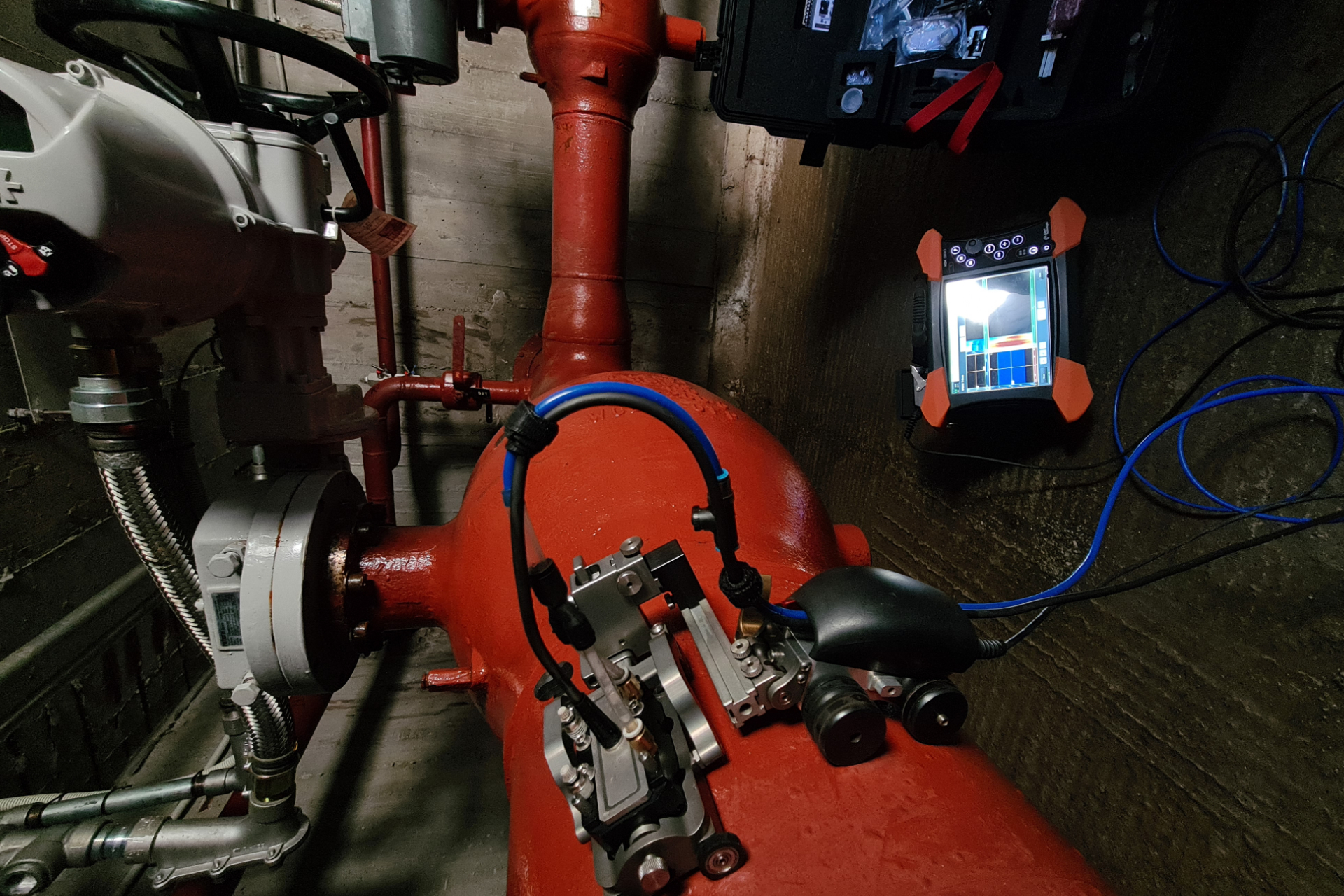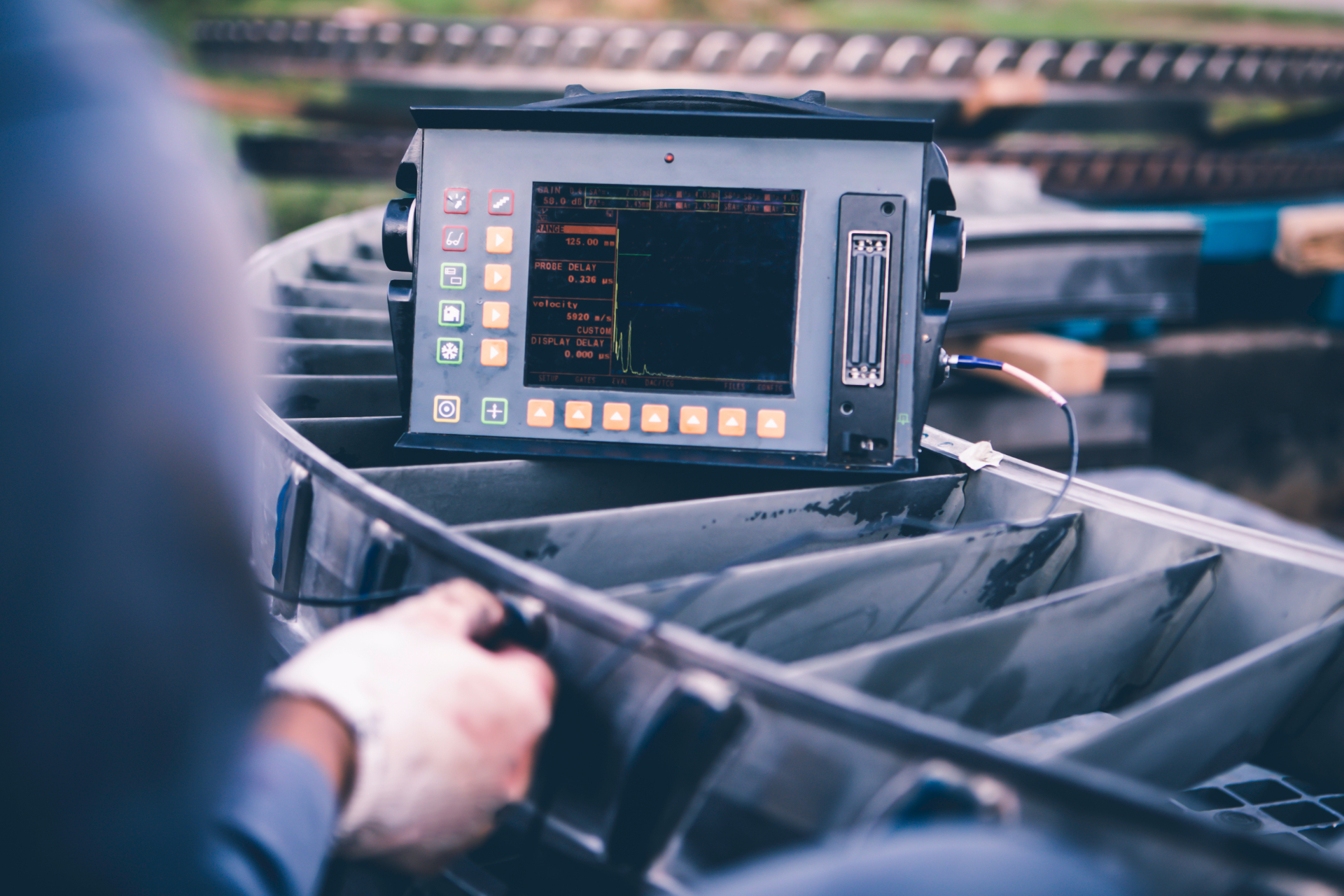Phased Array Ultrasonic Testing [PAUT]
Phased Array is an ultrasonic testing technique that uses specialised multi-element “array” transducers and pulses those elements separately in a patterned sequence called “phasing”. This phasing sequence allows wave steering, focusing, and scanning. This procedure is performed electronically.

PAUT utilises a set of ultrasonic testing [UT] probes made up of numerous small elements, each of which is pulsed individually with computer-calculated timing (“phasing”). When these elements are excited using different time delays, the beams can be steered at different angles, focused at different depths, or multiplexed over the length of a long array, creating the electronic movement of the beam. Phased array probes can be used manually in a free-running mode scrubbing the surface of a component, attached to an encoder to record position, or mounted on a semi-automated or motorised scanner for optimum productivity. Using phased array probes in direct contact with the component, whether mounted on a hard wedge, a water delay line, or even inside a wheel probe, gives inspectors the ability to quickly scan large areas for corrosion, cracking, and other defects with high resolution.
There are several advantages of PAUT that include, but are not limited to:
- Record keeping: permanent digital records accessible to everyone are generated
- Speed: rapid coverage of larger surface areas means PAUT can typically be conducted more quickly than conventional UT.
- Accuracy: by emitting beams of multiple different angles sequentially, PAUT is able to create detailed and accurate cross-sections of an asset, thereby increasing the probability of detecting anomalies.
- Repeatability: PAUT can easily be used for repeat scans due to its high degree of accuracy and consistency.
- Flexibility: PAUT has proven to be an effective technique for inspecting more complex geometries such as elbows, bends, and nozzles. PAUT is also particularly useful in situations where there is limited access for mechanical scanning because it’s able to sweep the beam without moving the probe.
- Safety: using a semi-automated or motorized PAUT scanner avoids exposing inspection personnel to potentially dangerous environments. Moreover, PAUT is an effective alternative to radiographic testing, eliminating the safety hazards associated with radiography.
- Coverage: by steering, focusing, and scanning the transducer beams, PAUT systems can be used to inspect large surface areas quickly with high resolution.
The key disadvantages of this testing method are:
- A higher initial cost: compared to conventional ultrasonic testing systems. However, as in every investment, PAUT will, long-term, result in faster, more accurate and efficient inspections maximising asset uptime, leading to a lower total cost of ownership.
- Difficult operation and data interpretation: therefore specially trained personnel is required, in order to eliminate the risk of inaccurate testing and to use the equipment to its full potential.
PAUT can be used to inspect almost any material where traditional UT methods are beeing utilised and is often used for weld inspections and crack detection.

As an advanced NDT method, PAUT is used to detect discontinuities to determine component quality, making it ideal for:
- Weld Inspections
- Thickness Measurements
- Corrosion Inspection
- Inspection of Rolling Stock Wheels and Axles
- Pressure Vessels
- Tanks
International Organization for Standardization (ISO)
ISO 19285 Non destructive testing of welds Phased array ultrasonic testing [PAUT] Acceptance levels (2017)
ISO DIS 4761 Non destructive testing of welds — Phased array ultrasonic testing [PAUT] for thin walled steel components — Acceptance levels (2021)
ISO TS 22499 Thermoplastic pipes for the conveyance of fluids — Inspection of polyethylene butt fusion joints using phased array ultrasonic testing (2019)
ISO TS 16943 Thermoplastic pipes for the conveyance of fluids — Inspection of polyethylene electrofusion socket joints using phased array ultrasonic testing (2019)
ISO 18563 1 Non destructive testing Characterization and verification of ultrasonic phased array equipment Part 1: Instruments (2015)
ISO 18563 2 Non destructive testing Characterization and verification of ultrasonic phased array equipment Part 2: Probes (2017)
ISO 19675 Non destructive testing Ultrasonic testing Specification for a calibration block for phased array testing [PAUT] (2017)
ISO 18563 3 Non destructive testing Characterization and verification of ultrasonic phased array equipment Part 3: Combined systems (2015)
ISO 5577 Non destructive testing Ultrasonic testing Vocabulary (2017)
ISO 13588 Non destructive testing of welds Ultrasonic testing Use of automated phased array technology (2019)
ISO 20601 Non destructive testing of welds Ultrasonic testing Use of automated phased array technology for thinwalled steel components (2018)
ISO 23243 Non destructive testing — Ultrasonic testing with arrays — Vocabulary (2020)
ISO 22232 -1 Non destructive testing — Characterization and verification of ultrasonic test equipment — Part 1: Instruments (2020)
ISO 22232 -2 Non destructive testing — Characterization and verification of ultrasonic test equipment — Part 3: Combined equipment (2020)
ISO 22232 -3 Non destructive testing — Characterization and verification of ultrasonic test equipment — Part 2: Probes (2020)
ISO 10332 Non destructive testing of steel tubes — Automated ultrasonic testing of seamless and welded (except submerged arc welded) steel tubes for verification of hydraulic leak tightness (2010)
ISO 23865 Non destructive testing — Ultrasonic testing — General use of full matrix capture/total focusing technique [FMC/TFM] and related technologies (2021)
American Society of Mechanical Engineers (ASME)
ASME Boiler and Pressure Vessel Code, Section V
This information is a collection of references. While we have made every attempt to ensure that information on this site is updated, Newtron is not responsible for any errors or omissions, or for the results obtained from the use of this information. It is not guaranteed to be complete, correct, current, or up to date and may be changed without prior notice.
